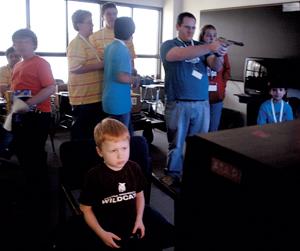GOLDSBORO — Blake Leftwich sat in a darkened room on the second floor of the Goldsboro Gaming Expo with a smile on his face.
Before him sat a sprawl of video game systems some have only seen in pictures.
An Atari 2600 wrapped in plastic, complete with joysticks and game cartridges.
An Intellivision still in its box.
There was even a Sega Genesis in prime condition.
Although the products on display were the fruits of his time spent rummaging through garage sales and thrift stores, the real objects of his affection lie further beyond the table — the people, young and old, male and female, huddled around the systems in action, playing games many haven’t played in a decade, if at all.
“Everybody really loves these old games,” Leftwich said. “They have a universal appeal.”
Rather than a gamer, Leftwich considers himself more a collector — interested in maintaining the memory of these clunky relics.
As he speaks on the subject, he periodically steps away to fuss over glitched systems to speak with customers about pricing and other information.
“Wow, that’s a good one,” he said, looking across the room at the distorted screen of Frogger.
He rushed to the aging system’s aid — jiggled this, adjusted that — and after a few seconds the little green frog was back on the screen, poised yet again to cross the perilous, pixelated highway.
For Leftwich, it all started with the Atari 2600.
When he was about seven or eight years old, he went to his cousin’s house, who had an Atari, and began to play Pac-Man.
“I did not want to stop playing it,” Leftwich said.
The following Christmas, he and his brother received the system for Christmas and it continued from there.
Sean Pate, a 24-year-old machine operator from Goldsboro in Leftwich’s room at the expo, said he remembered the system very well.
“Without that system starting everything, none of the systems would be around today,” Pate said.
And Leftwich agrees.
Despite other systems, like the Fairchild Semiconductor Channel F, he said the Atari was “the first huge, breakout, crazy-famous system.” “It came out in 1978 and they didn’t stop selling it until 1990,” Leftwich said. “That’s this thing’s shelf life.”
It was so popular in fact, that all types of companies — even Quaker Oatmeal — started making games for it. It’s what eventually led to the video game crash in the 1980s.
“Everybody started jumping on the video game bandwagon,” Leftwich said. “So many kids were burned by bad games.”
Although he has a full-time job as a manager at a Mt. Airy Blockbuster, Leftwich spends some of his free time going further with his hobby. He even started filming a half-hour show with his brother called Gamebot, which features game footage and commentary. The show airs in a few cities across North Carolina.
As for the games and systems he sells, Leftwich said it’s more about the labor than the profit. And it shows in the prices, which he said are the cheapest anyone can find.
“I wouldn’t go through the trouble if it was for money,” Leftwich said. “The truth is, with a little work, you can get any system for a decent price.”
Since he has no background in electronics, Leftwich said he and his brother share in a “disease” that compels them to hit up flea markets, thrift stores and garage sales, snatching up as many system components as they can. They restore them, package them with games and controllers, and off they go to whoever wants them.
Simplicity aside, there are reasons why these retro throwbacks keep resurfacing.
“Some people just enjoy the classics,” Allen Lin, master’s student in computer engineering, said.
If nothing else, Cherrie Ingals, a 39-year-old medical assistant from Goldsboro, said the nostalgia value is an attraction as well.
She named the games that she loved most when she was younger: Space Invaders, Pac-Man and one she couldn’t quite seem to remember.
“Missile Command?” Leftwich asked.
“Missile Command!” Ingals replied with a smile. “I loved that one. You didn’t even have to be good at it.”
Leftwich laments what he sees as a decline in the quality of games nowadays, a lack of creativity covered up by stunning graphics, complicated storylines and realistic violence.
He said the restrictions of the old systems forced designers to “be more creative” and said the lack of limitations have hindered that spirit.
“It’s become a big industry,” Leftwich said. “The fun part of games [is] few and far between.”
But he said the conservative nature of the gaming world, marked by continued sequels to blockbuster hits, is understandable when the creation of games now costs millions.
“Big industry goes with a formula that works,” he said. “When you have to spend millions, it’s not easy to take risks.”
Ingals also pointed out that games are more competitive than they used to be. Scores didn’t matter, points weren’t important and players didn’t have to be cutthroat competitive gamers to have a good time.
“They’re non-threatening,” Ingals said. “You don’t look at the numbers until the end.”
But although Pate said he loves old games and always will, it’s always good to “mix it up” with the latest and greatest in technology. An owner of a Nintendo GameCube and a PC, he sees the new age of gaming as a way to communicate between the young and old.
“It’s a good way to bridge the generation gap,” Pate said.
He also doesn’t see the computerized world in which he lives and breathes stopping anytime soon.
“As long as they keep ideas new, they’ll keep gamers coming back,” Pate said.








